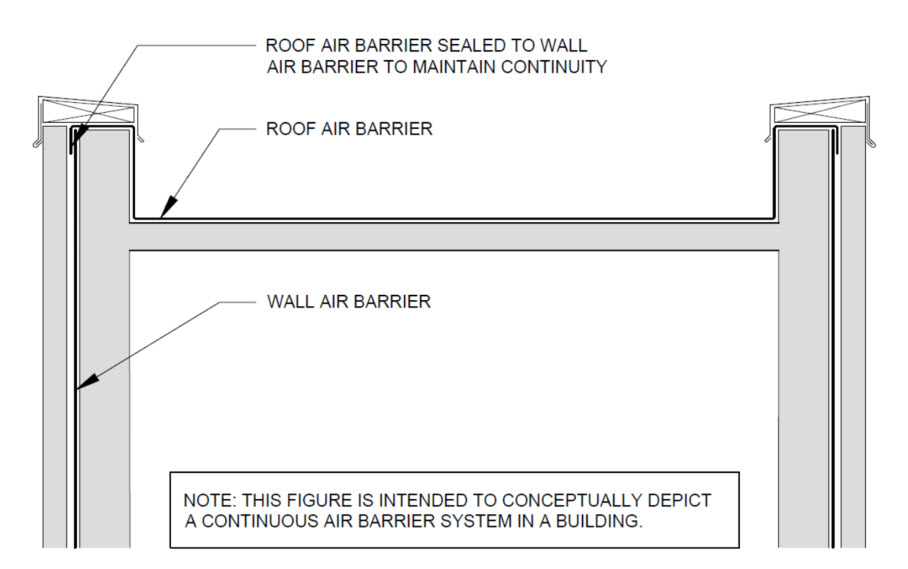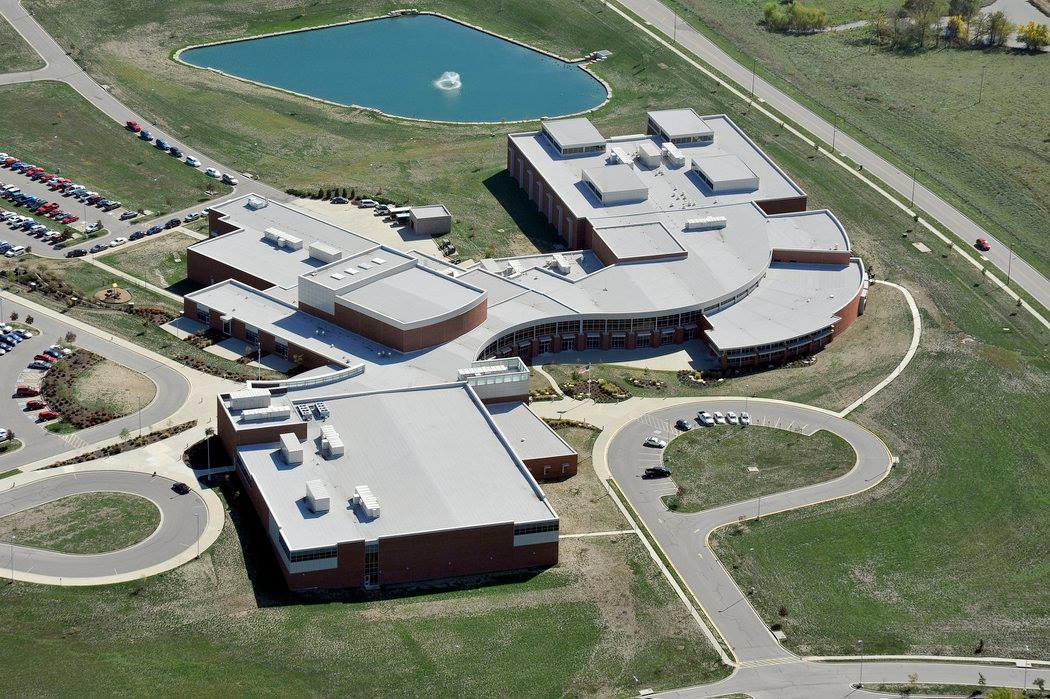More Than Just a Roof
Ensuring air barrier effectiveness
Air barriers are required to prevent the loss of conditioned air from within a building. Using the concept of a complete roof assembly, it is important to have an air control layer that is complete and uninterrupted throughout the building enclosure. The materials that are part of that control layer should stop air movement and all tie together so that the potential for leaks is minimized. An air barrier’s effectiveness can be greatly reduced by openings and penetrations, even small ones. These openings can be caused by poor design, poor workmanship, damage by other trades, improper sealing and flashing, mechanical forces, aging, and other forms of degradation.
The National Research Council Canada collected research data that illustrates how even small openings can affect overall air leakage performance. As an illustration, only about 1/3 of a quart of water will diffuse through a continuous 4 feet by 8 feet sheet of gypsum during a one-month period, even though gypsum board has a very high permeance. However, if there is a 1-square-inch hole in this same sheet of gypsum, about 30 quarts of water can pass through the opening as a result of air leakage. Air leakage can cause more moisture-related problems than vapor diffusion.
It is the responsibility of the registered design professional to determine the need for an air barrier, verify an air barrier’s compatibility with other materials, clearly identify all air barrier components of the envelope, and provide details on joints, penetrations, and transition areas. The building designer needs to specify that the membrane not just overlap the wall air barrier, but also be flashed or sealed to it so that air cannot escape.
The simplest approach for the roof designer is to designate the roof membrane as the air barrier and carry it up and over a parapet wall, or over the edge if a parapet wall is absent. Once overlapping the wall, it must be terminated and sealed to the wall air barrier material so that air and moisture leaks are prevented.
While more complex to design and install, it may be prudent to have the air control layer extend through the base of a parapet to the wall. At that point, it must be terminated and correctly sealed to the wall air barrier. This approach minimizes airflow into the parapet and lowers the risk of condensation within the parapet.

Image courtesy of GAF
Simplified detail where the roof and wall air barriers are connected and continuous.
Managing Efficiency at the Roof: Vapor Retarders
Vapor retarders are commonly used in low-slope roof assemblies to perform two functions. The first is limiting airflow into the roof assembly. Minimizing the movement of air into the roof assembly, called air intrusion, reduces the movement of moisture-laden interior air into the building’s roof assembly, where condensation may be a risk. Second, vapor retarders are installed to reduce diffusion of moisture vapor through roof materials. Buildings with a higher risk for this type of diffusion are those structures where the building’s interior humidity conditions are expected to be relatively high, such as in natatoriums, or where the building is located in a cold climate. Additionally, vapor retarders can be used to help address moisture issues that can occur with structural concrete roof decks that contain a latent amount of moisture. Vapor retarders are therefore designed to resist diffusion of moisture through roofs and mitigate condensation potential. They can perform a vital role in protecting interior IAQ, efficiency, and structural integrity of the building components where condensation can wreak havoc.
Since vapor retarders are used to slow migration of water vapor, they make an excellent application for situations where controlling moisture mitigation and lowering condensation risks are important. At present, vapor retarders are not a code requirement. When properly detailed, however, all vapor retarders are considered air barriers. Conversely, not all air barriers are vapor retarders, leading to much confusion in the industry. Because vapor retarders block air, they can be used as both the vapor and air control layer. That said, selecting this approach should be used with care, since the barrier’s ultimate performance is highly dependent on careful design and installation. When a vapor retarder is located in an unintended place, or incorrectly placed, the vapor retarder can trap moisture in the roof system. A vapor barrier in the incorrect location can be equally problematic to not having one where once should have been installed. To be successful, the designated air and vapor control layers must be understood by everyone involved in the design, construction, and installation processes. Pre-construction meetings that review the control layers are essential, particularly for school and healthcare buildings, where errors leading to IAQ and health concerns cannot be tolerated.
Vapor retarders material types
It is important to remember that all building materials have some vapor retarding properties, and the installation of a dedicated vapor retarder should be carefully considered. Most roofing membranes function as both air barriers and vapor retarders, and with correct application and detailing, they can meet the intent of the code. However, in low-slope roof assemblies there are several choices of possible materials for vapor retarders where a dedicated vapor retarder is required. Two categories of vapor retarders worth singling out are bituminous and non-bituminous. Bituminous-based vapor retarders are the most common and include self-adhering modified bitumen sheets and adhered smooth-surfaced APP or SBS-modified bitumen sheets. Additionally, there are built-up bituminous vapor retarders which are generally composed of one or two layers of asphalt felts or glass fiber mats applied with two or three applications of hot asphalt.
Non-bituminous-based vapor retarders include polyethylene film, plastic sheets, plastic laminates, kraft paper, kraft laminates and aluminum foil laminates. Some of these come with a self-adhering peel and stick backing and are generally self-sealing around fasteners. It is important to remember that vapor retarders, being installed lower down in a roof assembly, are frequently penetrated by fasteners from the insulation and membranes above, and installation of vapor retarders with self-sealing capabilities are advantageous to ensure that there is not air loss around penetrations.
There are non-bituminous types of vapor retarders that are installed loose-laid or adhered using a compatible adhesive to adhere the sheets to the roof deck or substrate. Black poly sheet, technically 6 mil polyethylene often referred to as Visqueen, is often used as a vapor retarder in residential crawl spaces. However, its use in roof systems is generally not recommended.

Source: Griffin & Fricklas (2006) Table 6.2
Table 1. Vapor retarding properties of common building materials.
Vapor retarders in different climate zones
Whether or not to add a vapor retarder to a roof assembly design is somewhat complex and can be a judgment call based on the designer’s experience. The designer should take into account factors such as: what is the building’s continuous air barrier strategy? What is the building’s intended use? For example, interior swimming pools for physical education in schools and physical therapy in healthcare facilities will add large amounts of moisture to the internal air and significantly raise the risk of condensation within the building enclosure. As a less obvious example, cafeterias and laundry rooms in schools and hospitals can also have high humidity levels due to cooking and oftentimes large congregations of people. For schools and hospitals where these types of interior spaces are present, it may be prudent to consider a dedicated vapor retarder at the deck level.
It is good to factor in what the designer’s experience has been. While some regions experience sub-freezing winter temperatures, some designers may have not seen condensation occurring even when not using vapor retarders. Often a combination of the local climate, building use, and the roof assembly typically used can lead to a low condensation risk. From the discussion so far, it could appear that vapor retarders are only considered for buildings in the north, or in climates that have cold winters. However, there are scenarios in warm climates where vapor retarders should be used. Many schools and hospitals feature large footprints that have poured concrete floors. In some cases, the building is closed up before the poured concrete floor has completely dried. While this allows other trades to commence work quicker, it can lead to very high interior humidity levels. It is not unusual for designers and developers of such buildings to include a vapor retarder in the roof assembly design. Another example would be where, during winter construction, where gas-fired interior heaters are used inside the building. The moisture created from the heaters can accumulate within the roof assembly. Many months later, once the floors are dry and the heaters removed, the risk of condensation is minimal, but the presence of a vapor barrier at the roof deck level can prevent condensation and related damage during construction.

Photo courtesy of Shaw Roofing
Blue Valley School: Use of a vapor retarder is a judgment call, in some cases, for the designer. Using a vapor retarder in buildings with large building footprints, such as schools, can mitigate any potential moisture risks from drying concrete floors.
Taking Performance to the Top
Ultimately, roofing, as with any project, is not a one-size fits all. The design begins with determining the appropriate roofing assembly, including consideration to the interior activities and room types, roof deck type, insulation and cover board selection, completing the design down to the last termination and penetration detail, and installing the roof in accordance with the contract documents. Roof system design that aligns with or exceeds the expectations for energy efficiency and performance should be considered best practice for the project. Project specific requirements should be considered to determine the best assembly for the project. In addition, selections should be considered to impact the life cycle of the roof assembly, as material selection may decrease the overall life of the system and lead to increased replacement intervals. Replacement intervals are of particular importance for hospitals and schools where considerations such as time of year, VOC levels, and noise produced from roof replacements can be added challenges to the project.
Membrane selection
Selection of the roof membrane, the waterproofing layer that protects the building, is critical for success. The main consideration is the membrane performance, including color, thickness, and attachment. Improper selection of the membrane can result in loss of energy efficiency, water infiltration into the building, costly repairs, or even replacement. Single-ply membranes include EPDM, TPO, and PVC. The primary difference between the membranes is chemical composition, performance when exposed to chemicals at the roof surface, and treatment of the seams. Single-ply membranes are the most popular roofing membrane today due to their ease of installation and low cost, compared to asphalt-based materials. Single-ply membranes are, as their name implies, a single layer of membrane roof material and are produced in rolls. The chemical make-up of each of the membranes is different, and therefore, each of the membranes is preferable in different applications. Most single-ply membranes perform well when exposed to chemicals, however, particular chemical compatibility should be consulted depending on intended exposure. PVC and PVC Kee are exceptional when exposed to animal fats and grease, which is advantageous when located above cafeteria spaces. Another difference between the single-ply membranes is the treatment of the seams. TPO and PVC membranes are heat welded at the seams, which produces a monolithic roof membrane. TPO and PVC membranes are also more tolerant of ponded water, although it is a best practice to create taper in the roof assembly so that water evacuates the roof. EPDM seams are adhered, which creates a strong seam, but over time the adhesives may become brittle or deteriorate, leaving open seams in the roofing membrane, which may be problematic for long-term performance.










